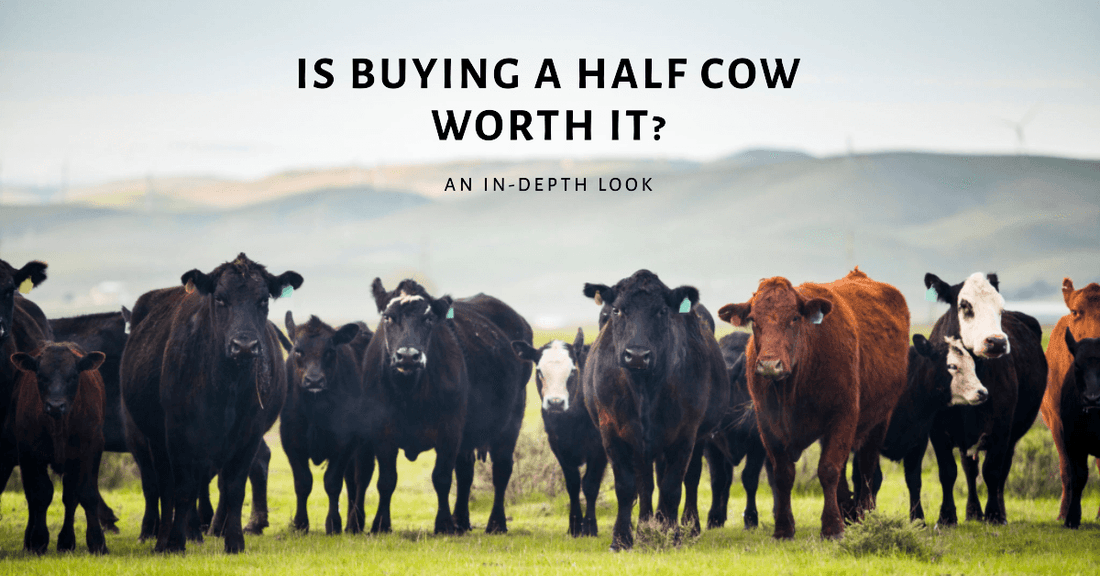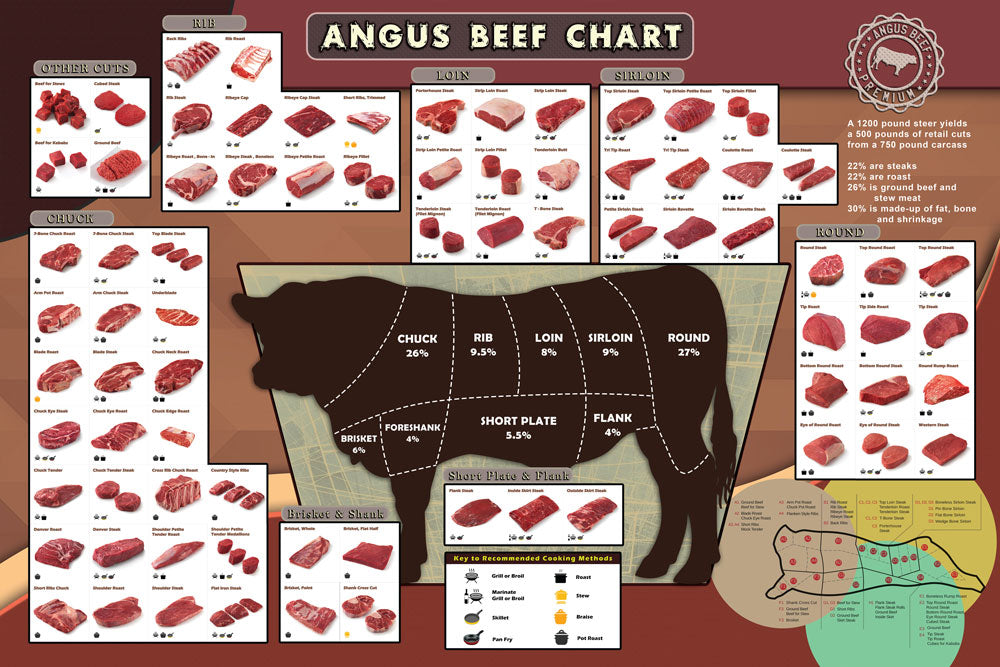Have you ever considered if buying a half cow worth it? While it might sound unconventional at first, this approach to purchasing meat offers a multitude of benefits, ranging from cost savings to supporting local farmers and ensuring higher quality meat for your family. This blog post will guide you through the ins and outs of buying half a cow, providing you with all the essential information you need to make an informed decision.
Join us as we explore the advantages of this unique approach to meat consumption, discuss the process of buying half a cow, and delve into more questions about the environmental impact and practical considerations of this choice. You'll learn about the various benefits, how to locate a local farmer, customize your order, and even how to share the experience with friends and family, all while answering the question: is buying a half cow worth it?
Short Summary
- Exploring the benefits of buying half a cow, such as cost savings and higher quality meat.
- Understanding the process from locating a farmer to receiving and storing beef.
- Evaluating environmental impact with sustainable farming practices, reducing food waste, and sharing with friends & family for cost savings & community building.
Exploring the Benefits of Buying Half a Cow
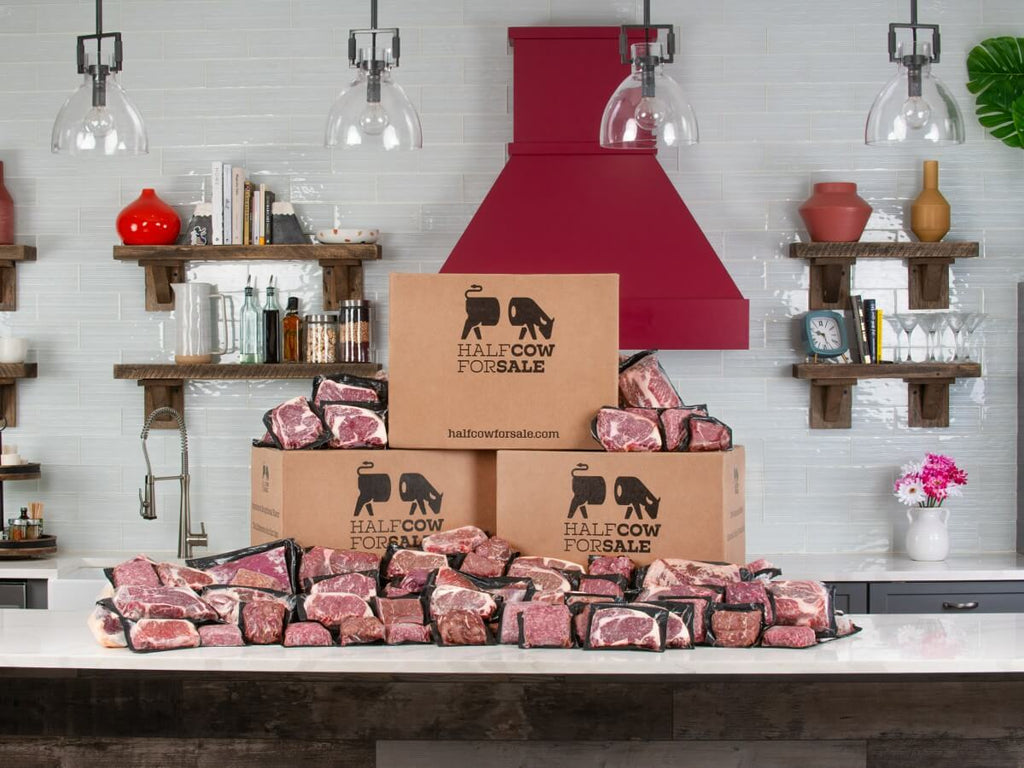
One of the primary motivations behind buying half a cow is the potential for significant cost savings. By purchasing in bulk, you can save between $1500 and $2000 annually. Comparing the price of grass-fed beef from the USDA Grass Fed Beef Reports we see consumers saving roughly 30.80% by purchasing bulk options rather than individual retail cuts attesting to the cost-effectiveness of this option, exact prices may vary slightly by geographical region or the time of year average savings are typically the same in terms of percentage.
Aside from the price advantage, buying half a cow also supports local farmers and provides you with higher quality meat. An example being HalfCowForSale.com's process of dry aging for at least 7 days before processing to improve the flavor of their angus beef. When you purchase directly from a farmer, you can be certain of the origin and quality of the meat, ensuring that it is free from antibiotics and hormones, and raised in a sustainable and humane environment. Additionally, you can expect a variety of cuts, such as steaks, roasts, brisket, and ground beef, with approximately 20% of packaged weight of the cuts being prime cuts like ribeye, T-bone, and sirloin.
Cost Savings
When you buy half a cow, you're not only getting a substantial amount of meat, but you're also getting it at a lower price per pound than if you were to purchase individual cuts. This can result in substantial savings over time, especially when you consider the frequency of trips to the grocery store you'll save and the reduced packaging waste.
Moreover, when properly stored, the meat from half a cow can last up to twelve months without any loss of quality. This means that you can have a steady supply of high-quality meat for an entire year without worrying about frequent trips to the store or fluctuating meat prices.
In the long run, buying the other half of a cow can prove to be a wise investment for both your wallet and your taste buds.
Supporting Local Farmers
By purchasing half a cow, you're not only getting great meat at a reasonable price, but you're also supporting local farmers who work hard to provide a quality product. This is a win-win situation for you, local farm and the local economy, as it encourages more sustainable and ethical farming practices while providing you with the best meat available.
Finding a local farmer to purchase half a cow from can be as simple as searching online, asking friends and family, or visiting local farmers markets. When you can buy beef directly from a farmer, you can also have the added benefit of customizing your order to include the specific cuts of meat, cut size, and fat content that suit your preferences and needs. This level of personalization is not typically available when purchasing meat from a grocery store.
Higher Quality Meat
The quality of the meat you get from purchasing half a cow is often superior to what you would find at a grocery store. Buying directly from a farmer means that you know exactly where your meat is coming from, and you can trust that it has been raised in a humane and sustainable environment. Dry-aged, grass-fed and grain-finished beef, for example, is known for its exceptional taste, tenderness, and health benefits compared to purely grass-fed and grass-finished beef which is more commonly found.
When you purchase a half of a cow, butchering it will produce various meat cuts. These can include steaks, roasts, brisket, ribs, stew meat, soup bones, and organ meats. Examples of organ meats are liver, heart, and tongue. This allows you to explore different recipes and cooking techniques, making mealtime more exciting and enjoyable for you and your family. With higher quality of meat products at your disposal, you'll be able to create memorable dishes that leave a lasting impression on your taste buds.
Understanding the Process of Buying Half a Cow
Finding a Local Farmer
The first step in buying half a cow is to locate a local farmer who offers this option. This can be done through online searches, word of mouth from friends and family, or by visiting local farmers markets. Once you have found a farmer, it's important to ask questions about their farming practices, the type of feed they use, and any certifications they may have, to ensure that you're getting the best quality meat possible.
It's also essential to inquire about the pricing structure and understand how the cost per pound is determined. Most farmers price their bulk beef based on the hanging weight, which is the live weight, of the carcass after it has been harvested and before it is cut into individual cuts. By understanding the pricing structure and asking the right questions, you can ensure that you're getting a good deal on your beef purchase.
Customizing Your Order
Once you've chosen a local farmer to purchase from, it's time to customize your order. This includes specifying the desired cuts of meat, the size of the cuts, and the amount of ground beef you'd like. Some farmers also offer the option to have the beef ground into hamburger patties or sausage, providing even more variety in your meat options.
When customizing your order, it's important to consider your family's preferences and dietary needs. If you have a large family or entertain guests frequently, you may want to request more popular cuts like steaks and roasts. On the other hand, if you're more adventurous in the kitchen, you might opt for lesser-known cuts or organ meats to experiment with new recipes and flavors.
Receiving and Storing Your Beef
After placing your order, the next step is to receive and store your beef. Proper storage is critical to maintaining the quality and freshness of your meat. Most farmers will provide the beef vacuum wrapped and sealed, which is the recommended packaging option for long-term storage. Vacuum sealing ensures that the meat remains fresh and free from freezer burn for an extended period.
When storing your beef, make sure to allocate enough freezer space to accommodate the large quantity of meat. A minimum of 10 cubic feet of freezer space is necessary to store half a cow. Proper organization and labeling of your beef will also help you keep track of your inventory and ensure that you're using the meat in a timely manner, so none goes to waste.
Preparing Your Home for Half a Cow

Before your beef arrives, it's important to prepare your home for this substantial quantity of meat. This includes making sure you have the necessary freezer space, as well as the appropriate cooking equipment and techniques to make the most of your purchase. By being well-prepared, you can fully enjoy the benefits of buying half a cow and create a variety of delicious meals for your family.
In this section, we'll explore the specific requirements for freezer space, discuss the recommended cooking equipment and techniques, and offer tips for meal planning and storage. With the right preparations in place, you'll be ready to embrace the experience of buying half a cow and savor the mouthwatering dishes that result.
Freezer Space Requirements
As previously mentioned, it's essential to have adequate freezer space to accommodate the substantial amount of meat you'll receive when buying half a cow. Approximately 8 cubic feet of freezer space should suffice for your beef storage needs. If you don't already have a stand-alone freezer, it's highly recommended to invest in one to ensure proper storage of your meat.
In addition to providing enough space for storage, it's also important to have a backup plan in case of power outages or other unforeseen circumstances. This can include having a generator on hand or making arrangements with friends or family to store your beef temporarily in their freezer if needed. Taking these precautions will help protect your investment and ensure that your meat remains fresh and safe to consume.
Cooking Equipment and Techniques
Having the right cooking equipment and techniques at your disposal is crucial when preparing meals with half a cow. A variety of cooking methods can be employed, such as braising, stewing, roasting, and grilling, depending on the cut of meat you're working with. Slow cooking methods are particularly suitable for tougher cuts of beef, as they help to break down the connective tissue and tenderize the meat.
In addition to standard cooking equipment like ovens and grills, you may also want to invest in specialized tools, such as a meat grinder, smoker, slow cooker, or pressure cooker. These appliances can help you make the most of your beef and explore new recipes and flavors. By mastering various cooking techniques, you can create an array of delicious dishes that showcase the exceptional quality of your half a cow.
Meal Planning and Storage
Effective meal planning and storage are essential when buying half a cow. By planning your meals in advance, you can ensure that all cuts of meat are utilized, and nothing goes to waste. Proper storage also plays a crucial role in maintaining the quality of your beef, so it's important to handle and store it correctly.
When planning meals with half a cow, consider the size of your family and the amount of time you have available to cook. Additionally, it's helpful to store the beef in meal-sized, frozen portions in the freezer, so you can easily take out what you need for each meal.
By staying organized and planning ahead, you can optimize the use of your beef and create a wide variety of satisfying meals for your family to enjoy.
Evaluating the Environmental Impact of Buying Half a Cow
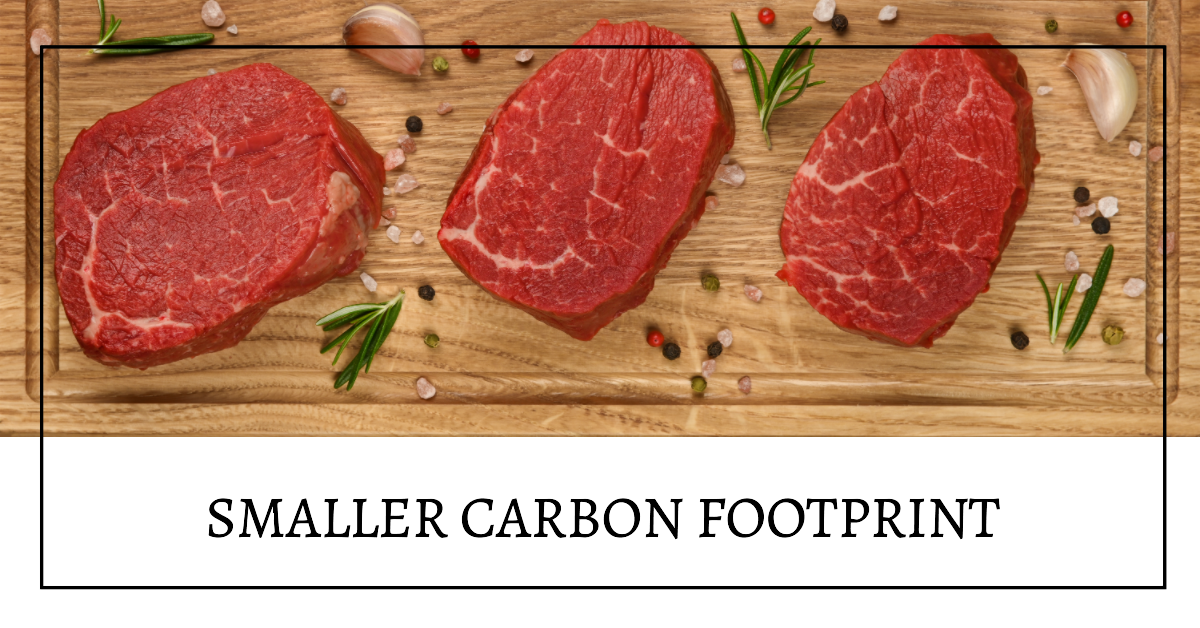
As with any significant purchase, it's important to consider the environmental impact of buying half a cow. Factors such as carbon footprint, sustainable farming practices, and reducing food waste all come into play when evaluating the environmental consequences of this decision. By being aware of these factors, you can make a more informed choice and minimize the ecological footprint of your meat consumption.
In this section, we'll explore the carbon footprint associated with buying half a cow, discuss sustainable farming practices that can help reduce the environmental impact, and offer tips for minimizing food waste. By understanding the environmental implications of your purchase, you can make a more responsible decision and contribute to a healthier planet.
Carbon Footprint
The carbon footprint of purchasing half a cow can vary depending on several factors that eat beef, such as transportation, processing, and packaging. Generally, beef has a greater carbon footprint than other meats, with an estimated 16.9 kg of CO2-eq for 50 grams of protein in beef production. However, buying from a farm like HalfCowForSale.com where the beef is born, raised and processed on the same farm can help reduce the carbon footprint associated with transportation through-out the cattle's life-time.
To further minimize the carbon footprint of your beef purchase, only consider buying from farmers like HalfCowForSale.com who employ sustainable farming practices, such as rotational grazing, composting, and cover cropping. These practices can help reduce the environmental impact associated with raising cattle and contribute to a more sustainable food system.
Sustainable Farming Practices
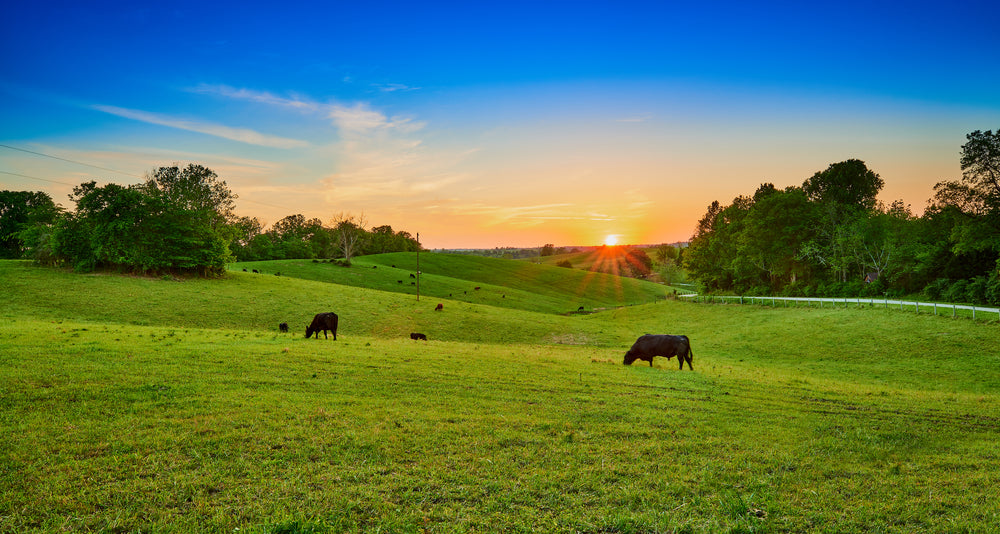 When purchasing half a cow, it's important to take into account the farming practices employed by the farmer. Sustainable farming practices, such as rotational grazing, cover cropping, and composting, can help minimize the environmental impact associated with raising cattle.
When purchasing half a cow, it's important to take into account the farming practices employed by the farmer. Sustainable farming practices, such as rotational grazing, cover cropping, and composting, can help minimize the environmental impact associated with raising cattle.
By buying from farmers who prioritize environmental conservation and animal welfare, you can support a more sustainable food system and ensure that your meat is of the highest quality. This not only benefits the planet, but also provides you with better tasting meat that you can feel good about consuming.
Reducing Food Waste
Minimizing food waste is another important aspect of buying half a cow. By planning your meals in advance and utilizing all of the cuts of meat, you can ensure that none of your purchases goes to waste. Proper storage is also crucial in preserving the quality and freshness of your beef, so it's important to follow best practices for storing and handling meat.
If you find that you have more beef than you can consume within a reasonable timeframe, consider sharing with friends, family, or neighbors. Not only does this help reduce food waste, but it also fosters a sense of community and enables others to enjoy the benefits of high-quality, locally-raised beef.
Sharing the Experience: Splitting a Cow with Friends and Family
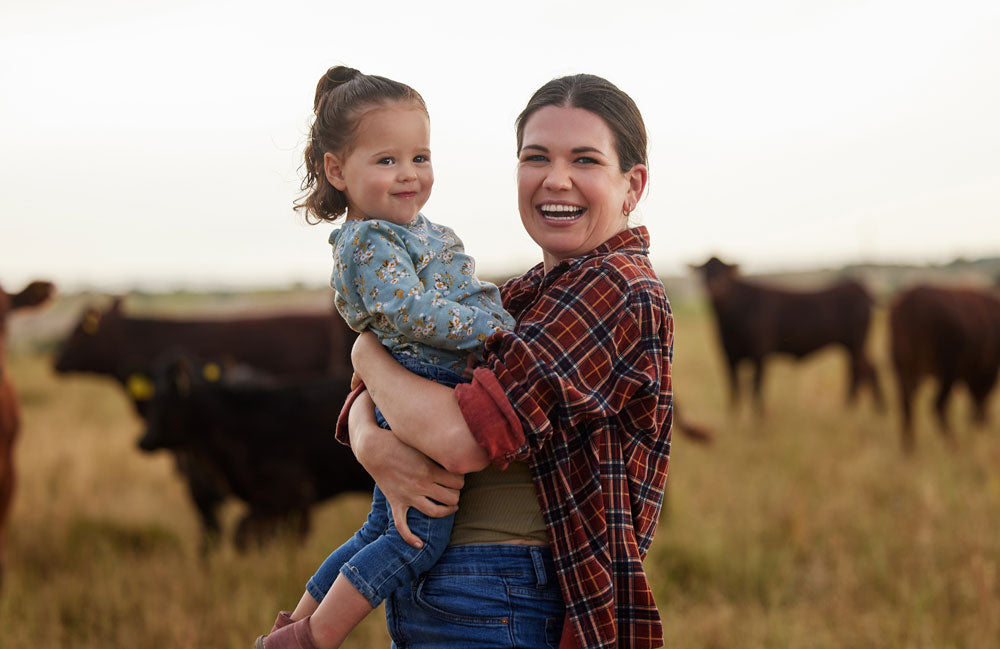
Sharing the experience of buying half a cow with friends and family can be a rewarding and cost-effective way to enjoy high-quality beef. By splitting a cow among a group, you can divide the expense of the butchered cow and obtain fresh, grass-fed meat at a more affordable price.
This section will discuss the benefits of sharing a cow, how to coordinate a cow share, and how to divide the beef fairly among the group.
Whether you're an experienced cook looking to experiment with new cuts of meat or a family seeking to save money on their grocery bills, sharing a cow can be a practical and enjoyable way to experience the many advantages of buying half a cow.
Benefits of Sharing a Cow
Splitting a cow among friends and family offers several advantages, including cost savings and access to a variety of cuts of meat. By sharing the expense of a butchered cow, each participant can enjoy the benefits of premium, grass-fed meat at a more affordable price.
In addition to the financial benefits, sharing a cow also fosters a sense of community and camaraderie among the group. Participants can exchange recipes, cooking tips, and even organize potlucks or barbecues to enjoy the fruits of their collective investment together.
This shared experience can create lasting memories and strengthen the bonds between friends and family.
Coordinating a Cow Share
Organizing a cow share involves several logistical aspects, including finding a farmer, determining the number of participants, and allocating the responsibilities for ordering, collecting, and storing the cow. Clear communication and cooperation among the group members are essential to ensure a smooth and successful cow share experience.
To facilitate the process, it's helpful to designate a point person to handle the logistics and coordinate the group. This person can be responsible for finding a local farmer, discussing the preferences of the group, and working out the details of the cow share arrangement.
By having a clear plan in place, the group can focus on enjoying the benefits of their shared purchase.
Dividing the Beef Fairly
When it comes to dividing the beef among the group, it's essential to ensure that the distribution is equitable and takes into account the individual preferences and needs of each participant. This can be achieved by assigning each person a specific number of cuts of meat to eat, or by dividing the order into equal parts based on weight or value.
Another method for dividing the beef fairly is to use a snake draft, where each participant takes turns selecting their desired cuts of meat in a rotating order. This ensures that everyone has an equal opportunity to choose the cuts they prefer and helps to maintain a fair distribution of the beef among the group.
Summary
Throughout this blog post, we've explored the many benefits of buying half a cow, including cost savings, supporting local farmers, and enjoying higher quality meat. We've also discussed the process of buying half a cow, from finding a local farmer to customizing your order, and receiving and storing your beef. Additionally, we've examined the environmental impact of this choice and shared tips for reducing food waste and promoting sustainable farming practices.
As we've seen, buying half a cow can be a rewarding and practical way to enjoy high-quality, grass-fed beef while supporting local farmers and minimizing your environmental footprint. By sharing this experience with friends and family, you can create lasting memories, strengthen bonds, and savor the delicious, mouthwatering dishes that result from your collective investment in half a cow.
Frequently Asked Questions
Does it make sense to buy half a cow?
Given the savings and convenience of having your own supply of quality meat for up to 1-2 years, buying half a cow makes perfect sense. The initial investment will be well worth it in the long run.
What is a fair price for half a cow?
For the purchase of half a cow, you can expect to pay between $2,200 - $2,700. This cost includes shipping and is calculated how much beef is at about $15 per pound.
Investing in quality meat for you and your family can be expensive, so it is important to weigh the options and ensure that you are making the best decision for your budget.
When you buy half a cow, what do you get?
Buying back half of a cow means you'll get approximately 180 pounds of beef, with 80 pounds of that being ground beef and the remaining portion divided into roasts, steaks, and other cuts like brisket, ribs, stew meat, and soup bones.
These cuts can be used for a variety of dishes, from burgers and tacos to roasts and stews. You and butcher can also choose to have the meat processed into sausages, jerky, and other specialty items. With half a cow, you'll have plenty of meat to last you for months.
Do you save money buying a quarter cow?
Buying a quarter cow can provide savings compared to the grocery store, but you won't get as much value as if you had purchased a whole cow or half cow. If the cost of buying a larger quantity is too great, then going with a quarter cow is a good option.
However, for maximum savings, buying a larger portion of beef is the way to go.

